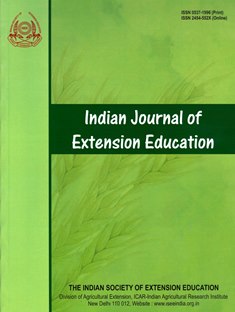A Cross-State Analysis of Livelihood Security Among Farm Women in Kerala and Manipur
DOI:
https://doi.org/10.48165/IJEE.2025.61404Keywords:
Farm women, Livelihood security, Sustainable development, IndiaAbstract
Farm women, having a pivotal role in agriculture, continue to face systemic barriers to livelihood security. This study was undertaken in 2022 to assess and compare the livelihood security, identify the constraints and formulate a sustainable livelihood security framework for the farm women in Kerala and Manipur state. Primary data were collected from 90 respondents using pre-tested interview schedule and validated with key local informants through focus group discussions. Descriptive statistics, frequency and Principal Component Analysis were used as statistical tools for data analysis. The findings revealed that 51.11 per cent of the respondents in Kerala and 64.44 per cent in Manipur had a moderate level of livelihood security. The first two components i.e. food and occupational security, could explain the total variance of 70.926 per cent for Kerala and 56.336 per cent for Manipur. The main constraints to livelihood security for farm women were insufficient funding and inadequate government support. Based on these findings, livelihood strategies were formulated for farm women and delivery system level to safeguard the livelihood outcomes. Designing interventions and policies aimed at ensuring farm women’s sustainable livelihood security will be significantly impacted by these findings and recommendations.
Downloads
References
Abhishek, P. J. (2023). An assessment of livelihood security among farm women. https://krishikosh.egranth.ac.in/handle/1/5810206082
Altenbuchner, C., Vogel, S., & Larcher, M. (2017). Effects of organic farming on the empowerment of women: A case study on the perception of female farmers in Odisha, India. Women’s Studies International Forum, 64, 28–33. https://doi.org/10.1016/j.wsif.2017.09.001
Amayo, F., Irene, L. A., Esuruku, R. S., & Kaptui, P. B. (2021). Farming methods and the livelihood outcomes of women in Eastern Uganda. Journal of Agricultural Extension and Rural Development, 13(3), 182–191. https://doi.org/10.5897/JAERD2021.1249
Asadullah, M. N., & Kambhampati, U. (2021). Feminization of farming, food security and female empowerment. Global Food Security, 29, 100532. https://doi.org/10.1016/j.gfs.2021.100532
Asha, E. J. (2020). Entrepreneurial behaviour of farmer producer organization (FPO) members for livelihood security. https://krishikosh.egranth.ac.in/handle/1/5810157578
Ball, J. A. (2020). Women farmers in developed countries: A literature review. Agriculture and Human Values, 37, 147–160. https://doi.org/10.1007/s10460-019-09978-3
Chandana, T. S., Praveena, P. L., Lakshmi, T., Subramanyam, D., & Reddy, B. R. (2023). Sustainable livelihood security of integrated farming systems practicing farmers through different enterprise combinations in Andhra Pradesh. Indian Journal of Extension Education, 59(1), 101–106. https://doi.org/10.48165/IJEE.2023.59121
Food and Agriculture Organization. (2018). Leaving no one behind: Empowering Africa’s rural women for zero hunger and shared prosperity. FAO. https://www.fao.org/gender/special-initiatives/leaving-no-one-behind/
Gautam, P. K., & Jha, S. K. (2023). Analysis of livelihood security of households: A case study from rural areas of Bundelkhand. Indian Journal of Extension Education, 59(1), 146–149. https://doi.org/10.48165/IJEE.2023.59131
Gebre, G. G., Isoda, H., Amekawa, Y., & Nomura, H. (2021). Gender differences in agricultural productivity: Evidence from maize farm households in southern Ethiopia. GeoJournal, 86(2), 843–864. https://doi.org/10.1007/s10708-019-10098-y
Hridya, S. (2018). Livelihood security assessment of women agripreneurs of self-help groups (SHGs) in Kerala. http://krishikosh.egranth.ac.in/handle/1/5810145875
Janani, H. K., Karunanayake, C., Gunathilake, M. B., & Rathnayake, U. (2024). Integrating indicators in agricultural vulnerability assessment to climate change. Agricultural Research, 13, 741–754. https://doi.org/10.1007/s40003-024-00727-5
Jannat, A., Islam, M., Alamgir, M., Al Rafi, D. A., & Ahmed, J. U. (2021). Impact assessment of agricultural modernization on sustainable livelihood among tribal and non-tribal farmers in Bangladesh. GeoJournal, 86(1), 399–415. https://doi.org/10.1007/s10708-019-10076-4
Manikanta, D., & Satpathy, B. (2023). Assessment of livelihood security and constraints encountered by small and marginal cotton growers. Indian Journal of Extension Education, 59(4), 44–48. https://doi.org/10.48165/IJEE.2023.59409
Matouleibi, T. M., Sagar, M., & Devayan, C. (2022). Assessment of preferences and achievements on livelihood security with respect to Tribal Sub Plan in Manipur. Journal of Community Mobilization and Sustainable Development, 17(4), 1388–1394.
Meshram, M., Singh, S. R. K., Dhenge, S. A., & Shrivastava, P. (2024). Sustainable livelihood for tribal farmers via integrated farming system components. Agricultural Research. https://doi.org/10.1007/s40003-024-00818-3
Mishra, M., Ravi, S. C., Verma, A. K., Gupta, A. K., Dubey, S. K., & Jaiswal, R. (2023). Assessing composite livelihood security and its determinants among rural households. Indian Journal of Extension Education, 59(2), 41–45. https://doi.org/10.48165/IJEE.2023.59209
Mohapatra, B. P., & Satpathy, A. (2018). Decision-making behaviour for empowerment of tribal and non-tribal farm women of Odisha. Journal of Pharmacognosy and Phytochemistry, 7(5), 2374–2377.
Nain, M. S., & Kumar, P. (2010). A study of women participation and decision-making in farm management. Journal of Community Mobilization and Sustainable Development, 5(1), 67–71.
Pattnaik, I., & Lahiri, D. K. (2021). Do women like to farm? Evidence of growing burdens of farming on women in rural India. Journal of Peasant Studies, 49(3), 629–651. https://doi.org/10.1080/03066150.2020.1867540
Pradhan, S., Naberia, S., Harikrishna, Y., & Jallaraph, V. (2020). Livelihood security of small farmers in Jabalpur District of Madhya Pradesh. Indian Journal of Extension Education, 56(4), 98–102. https://doi.org/10.48165/
Rathod, R. B., Bhopala, U. D., & Dhola, A. B. (2023). Livelihood security of small and marginal farmers towards agricultural diversification. International Journal of Agriculture Extension and Social Development, 7(1), 141–143. https://doi.org/10.33545/26180723.2024.v7.i1b.201
Rejula, K., Singh, R., & Nain, M. S. (2017). Rice farming for food security and ecological sustainability: An analysis of farmers’ awareness in Kerala. Indian Journal of Extension Education, 53(4), 101–106.
Rukmani, R., Gopinath, R., Anuradha, G., & Yadav, V. K. (2019). Women as drivers of change for nutrition-sensitive agriculture: Case study of a novel extension approach in Wardha, India. Agricultural Research, 8, 523–530. https://doi.org/10.1007/s40003-018-0383-x
Santhi, S., & Kalirajan, V. (2018). Study the profile characteristics of farm women with reference to decision-making behaviour. Asian Journal of Agricultural Extension, Economics & Sociology, 29(1), 1–5. https://doi.org/10.9734/AJAEES/2019/45772
Sathwika, B., Rani, R. N., Reddy, R. G., & Sreedevi, P. (2019). A study on existing livelihood systems and livelihood security of rural women in Telangana state. The Pharma Innovation Journal, 8(6), 278–281.
Tong, Y., Shu, B., & Piotrowski, M. (2019). Migration, livelihood strategies, and agricultural outcomes: A gender study in rural China. Rural Sociology, 84(3), 591–621. https://doi.org/10.1111/ruso.12255
Ugwu, P. (2019). Women in agriculture: Challenges facing women in African farming [Project report]. African Women in Agriculture.
Downloads
Published
Issue
Section
License

This work is licensed under a Creative Commons Attribution-NonCommercial-NoDerivatives 4.0 International License.

